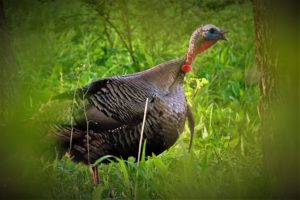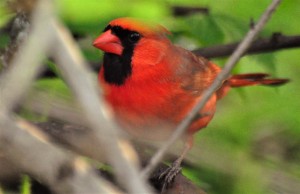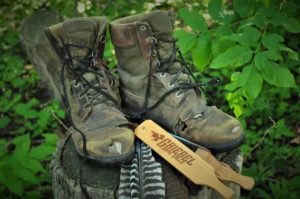Photography courtesy of Lowell Washburn, all rights reserved.
There are just some things that a person can’t get enough of. Like observing and listening to wild turkeys as they move about in their natural woodland habitats. Iowa’s spring hunting seasons are over, of course. But that doesn’t necessarily mean that anyone has to quit messin’ with willing gobblers. It just means that you can’t bring any of them home to eat; at least until the fall season opens in October. But then, who’s counting?
Although early morning gobbling has certainly backed off from the intensity seen during early spring, Long Beards are still sounding off across Iowa – some more than others. By the time we get past the first week of June, the collective vocalizations have become highly unpredictable. Late, end-of-the season gobbling is random at best. Like the bird that didn’t decide to fire up until 8:20 this morning.
When I first heard the bird, he sounded a long way off. But by then the wind was already roaring at 25 mph and the foliage was loud. The tom had to be closer than his gobble suggested. I decided that if I could hear him, he could most definitely hear me.
I stepped up the calling, and the turkey was soon talking back with increased enthusiasm. Pretty soon the gobbler began moving in my direction. Five minutes later and he was getting very close. With the gooseberries almost shaking with the volume, I expected to see the tom at any moment.
Then, off to my right, a sudden movement through the leaves and a tiny spot of cardinal red caught my eye. Slowly moving the lens in that direction, I prepared to drop the shutter once the tom came into full view. Another flash of red and then there he was. Standing in the wide open, it was — well it was a beautiful male cardinal.
I called again. Silence. A minute later I detected another movement and then suddenly there he was. This time it was the real McCoy – a magnificent mature gobbler.
But now that he had arrived, the Long Beard displayed little interest in asserting dominance over the decoy. Instead, he simply did a deliberate slow motion walk by, swapped ends, and then started back the way he came. Within seconds the tom had disappeared back into the dense shrubbery. He was still sounding off though; each call growing fainter than the one before. With the gobbler now out of sight and moving away, I decided it would be a good time to fold up the blind and sneak out of the woods. I wish the bird would have hung around for a bit longer, of course. But although the show had been brief, any Gobbler Close Encounter makes getting into the woods well worth the effort!
LW




 Susan Judkins Josten
Susan Judkins Josten Rudi Roeslein
Rudi Roeslein Elyssa McFarland
Elyssa McFarland Mark Langgin
Mark Langgin Adam Janke
Adam Janke Joe Henry
Joe Henry Sue Wilkinson
Sue Wilkinson Tom Cope
Tom Cope Kristin Ashenbrenner
Kristin Ashenbrenner Joe Wilkinson
Joe Wilkinson Dr. Tammy Mildenstein
Dr. Tammy Mildenstein Sean McMahon
Sean McMahon